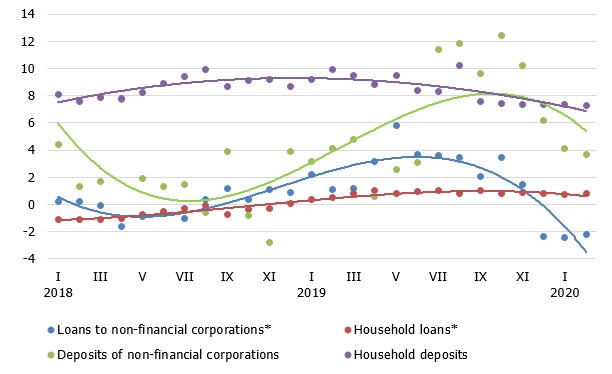Banks, Direct Speech, Economics, Financial Services, Latvia
International Internet Magazine. Baltic States news & analytics
Wednesday, 24.12.2025, 03:03
Monetary aggregates are on sick leave
 Print version
Print versionContinuing the trend observed in the previous months, the domestic loan portfolio of banks also decreased in January and February. Banks' conservative lending policies and the growing caution with which businesses view the economic outlook were accompanied by one-off factors, i.e. the changes in the classification of institutional sectors (a row of state and local government commercial companies were included in the general government sector as of 1 January) seen in January and the cancellation of the AS PNB Banka's licence in February.
The situation has abruptly changed in March. The increasing impact of the coronavirus outbreak on both the global and Latvia's economies leads to significantly reduced opportunities for businesses and households to make savings. Consequently, deposits with banks will follow a downward trend. With creditworthiness deteriorating and cash flow gaps occurring, the loan portfolio is also most likely to decrease further; however, the negative economic effects of the virus outbreak could be mitigated by wider fiscal policy support, inter alia, the government support measures for businesses and their employees. At the same time, ultra-accommodative monetary policy and the flexible approach of the banking sector to debt restructuring will help handle liquidity problems and ensure favourable financing conditions to economic agents.
Returning to the actual data for the beginning of this year, the domestic loan portfolio shrank by 1.7% in January and February, with loans to non-financial corporations and households contracting by 2.9% and 0.2% respectively. As a consequence, in February the annual rate of change in domestic loans (excluding the impact of the banking sector structural changes and the changes in the classification of institutional sectors) stabilised in negative territory at –1.4% for loans overall and –2.2% in the case of loans to non-financial corporations. A marginally positive annual growth rate was reported only in lending to household (0.8% including 1.2% for loans for house purchase). The dynamics of new loans was rather weak; however, they showed a slight improvement – the amount of new loans granted in February posted an increase compared to January and even the same period a year ago.
In January and February, domestic deposits edged down by 0.8%, including a 2.0% decline in deposits by non-financial corporations and a 0.3% increase in household deposits. As a consequence, in February the annual growth rate of domestic deposits accounted for 6.4%, including those of non-financial corporations and households at 3.7% and 7.3% respectively.
Annual changes in domestic loans and deposits (%)

- 28.01.2022 BONO aims at a billion!
- 25.01.2021 Как банкиры 90-х делили «золотую милю» в Юрмале
- 30.12.2020 Накануне 25-летия Балтийский курс/The Baltic Course уходит с рынка деловых СМИ
- 30.12.2020 On the verge of its 25th anniversary, The Baltic Course leaves business media market
- 30.12.2020 Business Education Plus предлагает анонсы бизнес-обучений в январе-феврале 2021 года
- 30.12.2020 Hotels showing strong interest in providing self-isolation service
- 29.12.2020 В Латвии вводят комендантский час, ЧС продлена до 7 февраля
- 29.12.2020 В Rietumu и в этот раз создали особые праздничные открытки и календари 2021
- 29.12.2020 Latvia to impose curfew, state of emergency to be extended until February 7
- 29.12.2020 18-19 января Наталия Сафонова проводит семинар "Управленческий учет во власти собственника"








 «The Baltic Course» Is Sold and Stays in Business!
«The Baltic Course» Is Sold and Stays in Business!

